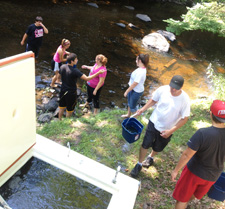Stocking
 The Keweenaw Bay Indian Community raises lake trout, brook trout, and walleye for stocking into western Upper Peninsula of Michigan waters. The stocking program began in 1993 and fish stocking has been completed each year since that time. Stocking records are maintained at the Natural Resource Department offices and information is shared with other organizations. Stocking has occurred at 97 locations within 56 separate water bodies within the six counties of the western Upper Peninsula, including 29 locations on the L'Anse Indian Reservation.
The Keweenaw Bay Indian Community raises lake trout, brook trout, and walleye for stocking into western Upper Peninsula of Michigan waters. The stocking program began in 1993 and fish stocking has been completed each year since that time. Stocking records are maintained at the Natural Resource Department offices and information is shared with other organizations. Stocking has occurred at 97 locations within 56 separate water bodies within the six counties of the western Upper Peninsula, including 29 locations on the L'Anse Indian Reservation.
KBNRD has developed and managed biologically and genetically unique strains of fish for its hatchery programs, including the Jumbo River strain of brook trout, Traverse Island strain of lake trout, and unique strains of coaster brook trout from Isle Royale, to name a few. Before these strains were selected for rearing, intensive and at times exhaustive research was done to ascertain the unique characteristics for each.
Current stocking target numbers are 25,000 walleye 30,000 coaster brook trout, 40,000 stream brook trout, and 50,000 lake trout fingerlings. The majority of our stocking effort is immediately on or near our L'Anse Indian Reservation, with additional stocking into waters in areas further afield when stock is available.
Lake Trout (Chinamekos)
Since 1993 our Community has raised and stocked lean lake trout into Lake Superior to help restore populations to self-sustaining levels. In December of 2010 our Lake Trout stocking program passed the 1.5 million mark for total lake trout stocked into Lake Superior since 1993. Since the founding of our Natural Resource Department our lake trout rearing and stocking program and our hatchery facility have been active participants in the Fishery Restoration Plan for Lake Superior developed by the Great Lakes Fishery Commission and we’re very proud of our participation. According to our Natural Resource Department staff the lake trout that we stock make up about 50% of the lean lake trout present in lower Keweenaw Bay, helping to make Keweenaw Bay one of the best lake trout fisheries in Lake Superior.
Brook Trout
Since 1997 our Community has been stocking brook trout to restore depleted populations in the western Upper Peninsula of Michigan. The brook trout we raise for stocking is a Lake Superior basin strain we developed from the Jumbo River in the Ottawa National Forest.
In addition to our Jumbo River brook trout we also stock Siskiwit Bay strain coaster brook trout into local waters. Coaster brook trout were once common along the south shore of Lake Superior, but are now fairly rare since overfishing, habitat degradation, and non-native species introductions severely reduced their numbers to a few remnant populations.
Since we began our brook trout rearing program in 1997, our Natural Resource Department has stocked over 900,000 brook trout into Western Upper Peninsula streams and rivers to help restore populations of this native trout to the area.
Walleye (Ogaa)
 For many years our Community has wanted to develop a walleye rearing and stocking program to raise walleye for stocking into local waters. Construction of our walleye rearing facility was completed in 2008, and in 2009 we started raising walleye for stocking. Capacity expansion plans are being developed to add additional acreage to the current facility. The first year produced 16,450 walleye, 3-6 inches in size, which we stocked into Keweenaw and Huron Bays.
For many years our Community has wanted to develop a walleye rearing and stocking program to raise walleye for stocking into local waters. Construction of our walleye rearing facility was completed in 2008, and in 2009 we started raising walleye for stocking. Capacity expansion plans are being developed to add additional acreage to the current facility. The first year produced 16,450 walleye, 3-6 inches in size, which we stocked into Keweenaw and Huron Bays.
From 2010-2012 over one million walleye of varying age classes have been stocked into Keweenaw Bay, Portage Lake/Pike Bay, and Huron Bay.
Year Number of Walleye Stocked
2010 12,581
2011 322,000
2012 860,768
Outside contributors to the KBIC walleye program include the Bad River Band of Lake Superior Chippewa, Sault Ste. Marie Tribe of Chippewa Indians and the Inter-Tribal Fisheries Assessment Program.
The KBIC walleye program is still a work in progress. We are still learning what the rearing ponds are capable of, still trying to develop assessment plans for walleye in regional lakes/waters of interest, and are still working to establish hey components of our walleye rearing capabilities (i.e. incubation building and support equipment).
